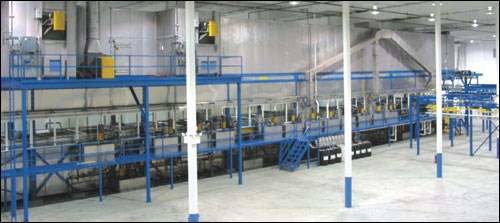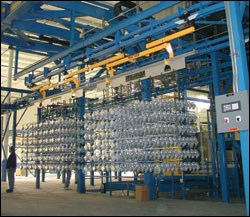Electrocoat Earns an ‘A’
When it wanted to expand its profits and customer base, Detroit-based Burkard Industries added Class A electrocoating to its repertoire of services...
In today’s challenging business climate, diversification is the order of the day for companies seeking to grow their business and expand their customer base. Burkard Industries— a contract shop located in Clinton Township, Michigan—is doing just that by adding electrocoat to its repertoire.
Originally conceptualized as a manufacturer of caskets, the company was founded in 1934 by John Adam Burkard working out of his garage. Three years after its inception, Burkard moved the business into a factory location and expanded into die casting of casket hardware. Manufacturing of zinc die castings for marine, automotive, recreational vehicle, and commercial hardware industries soon followed, as did the introduction of chrome plating.
In 1988, in response to the growing demand for powder coatings, Burkard Industries installed its first powder coating line. A second line followed in 1995 and the plant doubled in size from 20,000 sq. ft. to 40,000 sq. ft. A year later, a third powder coating system designed for prototype and custom work was introduced.
Today, the business is owned and operated by the founder’s great-grandson, Jay Burkard. Because of its proximity to the heart of the American automobile business (Clinton Township is a suburb of Detroit), Burkard in 2002 made the decision to expand the business to 78,000 sq ft and purchase an electrocoat system, capable of applying a Class A automotive finish.
Bringing Electrocoat Into the Mix
For Mr. Burkard, part of the appeal of electrocoat is its ability to "work and play well" with powder coating. He did not want the introduction of the electrocoating technology to come at the expense of the powder coating business. “We were looking to grow the powder business through the electrocoat capabilities,” says Mr. Burkard. “We built in Class A [a finish with the fewest surface defects and most consistent color and gloss] capabilities into the electrocoat line, because we want to be able to top-coat over it.”
Electrocoat also has merit as a stand-alone finish. Though many of the components coated by Burkard are “under the hood” items and will never be seen by the large majority of consumers, a quality finish is critical. Burkard has always specialized in masking and has extended its masking expertise into the electrocoat arena. Gas tank filler tubes, for example, which are masked to keep coating out of the interior and require a high degree of corrosion resistance, are an ideal job for electrocoat.
In identifying the need for a new system, Burkard considered a number of factors, including:
- The need to deliver a Class A finish
- The system should occupy as little plant floor “real estate” as possible
- The ability to mask and load parts efficiently from different loading stations.
After exploring a number of options, Burkard opted for a SlideRail Square TransferTM (SST) electrocoating system from Therma-Tron-X, Inc. (TTX) of Sturgeon Bay, Wisconsin. The SST concept allows for combination immersion and spray pretreatment, electrocoating and curing in a fraction of the space (40-60%) required by traditional monorail systems. “In an SST system, you have the oven located overhead and the pretreatment and electrocoat tanks down below,” said Jim Miller, Sales Engineer for Therma-Tron-X, Inc. “As a result, you have two large components of the system utilizing the same amount of floor space.” And unlike monorail systems - which require that the part is moving continuously during its dwell time – square transfer systems keep the part stationary during the dwell portion of the cycle. Parts are vertically lowered into and raised out of all process tanks simultaneously and indexed from one stage to the next in unison. Consequently, the tanks only have to be marginally larger than the largest part being coated.
The SST at Burkard contains a 14 stage zinc phosphating pretreatment section, which includes three initial cleaning stages (immersion, spray, immersion) followed by a spray rinse and an immersion rinse. An acid pickling stage is also an option for chemical removal of residual smut, laser and weld scale, and other inorganic impurities before the zinc phosphate conversion coating is applied. Two final reverse osmosis (RO) rinses ensure a contaminant-free surface for paint deposition. Burkard then applies DuPont CorMax® VI electrocoat paint followed by an immersion permeate, spray permeate and a final RO rinse. The system is equipped with bag filters on every pretreatment, electrocoat and post rinse stage, and has a dual zone curing oven with individual controls for each zone.
The SST is also equipped with a specially designed power and free conveyor system (manufactured using Jervis B. Webb components), which allows Burkard operators to load and unload at any of four spurs, while parts carriers are continually routed through on an inner bypass – much as railroad trains stop on side tracks at stations while leaving the main line clear. Carriers “parked” in the spurs offer stationary platforms for loading and unloading of parts, and also allow different high volume parts to be processed from unique locations simultaneously, minimizing clutter from packing materials and streamlining material handling processes.
Integral to the routing process of the power and free carriers is the use of an automatic identification system manufactured by Smarteye Corporation of Rochester Hills, Michigan. With the Smarteye Reader System, each conveyor carrier in the system is outfitted with a Smarteye Label which provides the carrier with a unique number for identification. Unlike bar code labels or RF tags, these labels are designed for use in the harshest manufacturing environments. They are constructed of 12 gauge steel and have Smarteye’s proprietary bit pattern cut into them.
Each load/unload station has a small data entry panel into which line operators specify pre-set system paths, which are relayed to the Programmable Logic Controller (PLC). The path not only specifies the load/unload position to which the carrier should return, it also indicates if any processing steps are to be skipped. For instance, parts may bypass the pickling stage (and subsequent rinse and neutralization tanks), or be designated for pretreatment only and held up over the paint stages.
Smarteye Readers, comprised of an infrared sender-receiver, are located at key decision points in the conveyor system to identify the loadbar carriers and route them accordingly. For instance, when operators load and release a carrier onto the main conveyor loop, a Smarteye Reader identifies the carrier along the way. As the load is transferred into the SST itself, another reader scans the carrier number and sends this data to the PLC. The PLC then sets the SST system parameters for processing those parts according to the path entered by the operator during loading.
At the same time, each carrier load is tied to a specific time frame using the Therma-Tron-X, Inc. Data Management System. Data acquisition hardware stores vital readings of system performance (saving them to a designated location on the plant computer network) which operators can review at a later time. If problems arise with a finished product, the Data Management System can be used to verify the process path and retrieve system information such as tank and oven parameters to determine whether the product was properly processed. This information is critical to Burkard Industries for real time process monitoring and ISO/QS lot control requirements.
Subsystems covered include pretreatment, electrocoat bath, oven performance, utilities usage and wastewater treatment. The system monitors itself 24 hours a day and will send detailed alarm messages in text format to key personnel’s cell phones if a critical piece of equipment goes down or there is a power interruption. The system is set up to allow engineers from Therma-Tron-X, Inc. to remotely monitor system parameters over the internet, if needed, for problem solving.
This automatic identification and tracking procedure helps to maximize the productivity and profitability of the SlideRail Square TransferTM (SST) electrocoating system, as the SST is responsible for coating numerous parts that undergo many different treatment regimens.
Though Burkard is currently using its electrocoat system as a one-color system, Therma-Tron-X set it up as a two-color system, providing Burkard the ability to add a second color down the road should the company choose to do so.
Ongoing Benefits
According to Mr. Burkard, the introduction of electrocoat technology to his facility has already had a substantial impact on his company’s business. “Our electrocoat sales have steadily improved each month as we reach out to new customers,” he said. “We’ve also seen an immediate impact on our powder sales as the new electrocoat line has opened many opportunities for parts requiring electrocoat and powder coat.” Most of the new business is automotive, but Burkard is also looking at some non-automotive business for electrocoat / powder coat including some appliance applications.
The electrocoat line has also had some unexpected positive impact on Burkard’s powder business. This includes powder coat orders from new electrocoat customers that want to minimize their supply base and are looking for one shop that can provide multiple services. And as the word spreads about quality capabilities of the new electrocoat line and the existing powder coat operations, Burkard is starting to see its geographical area of customers extend more throughout the Midwest and more into Canada.
Web Industries Inc.
Read Next
Episode 45: An Interview with Chandler Mancuso, MacDermid Envio Solutions
Chandler Mancuso, technical director with MacDermid Envio discusses updating your wastewater treatment system and implementing materials recycling solutions to increase efficiencies, control costs and reduce environmental impact.
Read MoreA ‘Clean’ Agenda Offers Unique Presentations in Chicago
The 2024 Parts Cleaning Conference, co-located with the International Manufacturing Technology Show, includes presentations by several speakers who are new to the conference and topics that have not been covered in past editions of this event.
Read MoreDelivering Increased Benefits to Greenhouse Films
Baystar's Borstar technology is helping customers deliver better, more reliable production methods to greenhouse agriculture.
Read More



















.jpg;maxWidth=300;quality=90)




